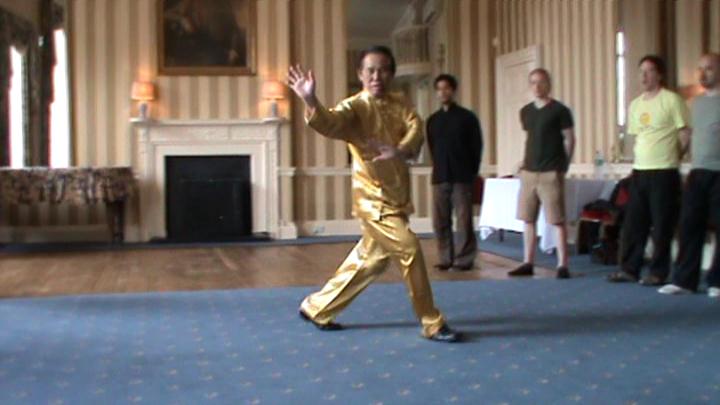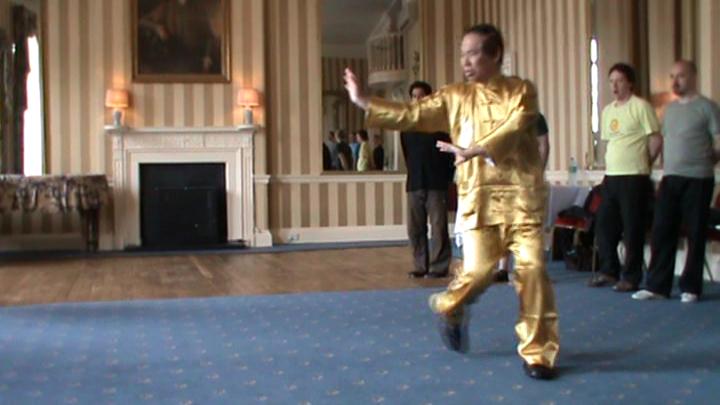COMMENTS ON SONGS OF BAGUAZHANG

Grandmaster Wong demonstrating Baguazhang Circle Walking
Question
A related question I have is how useful would a study of the "Songs" and "Methods" of Baguazhang be for us? How should we reconcile some of the "Songs" and "Methods" which might seem contradictory to the way we do things in Shaolin Wahnam, such as the mentions of "keeping the mouth closed" and "breathing only through the nose"? Are there certain "Songs" and "Methods" that are particularly useful for us modern practitioners of Baguazhang?
An English translation and commentary of the "Songs" and "Methods" of Baguazhang by Master Liang Shou-Yu (co-author with Dr. Yang Jwing-Ming of Emei Baguazhang) can be found here.
Frederick Chu
Answer
Regarding the "Songs" and "Methods" mentioned on the internet, the following are some of the differences between what is advised and what we do in our school.
- When you walk, the entire body should not sway. All of this relies on the two calves under the knees crossing each other firmly. Though the stability of the lower section of the body concerns the balanced waist and tights, the middle section of the body also needs the legs and waist.
This principle is also true in the Baguazhang we practice in our school, but not true in some styles, like the Monkey where the body is often bent forward to reduce its size, and the Drunken Eight Immortals where the body is purposely swayed from side to side for deception.
- Likely touch the lips, close the mouth, the tongue touches the roof of the mouth. In breathing the air is all entered from the nose. When manifesting force to its maximum, use the "hen" and "ha" sounds to emit. Unite the whole original chi as one, it is called "gaining".
In Baguazhang as well as in all other styles, we usually keep our mouth gently open. We breathe in through the nose and breathe out through the mouth, or we may not worry about breathing at all. We can make any sounds, including the "hen" and "ha" sounds if we like, or we may not make any sounds. We can do this because of our chi flow.
We may follow the advice if we like, but it would not be as effective as our own way.
- Baguazhang has a great difference from other kungfu styles. Stepping forward with moving front leg first is able to achieve success. When stepping backward the rear foot should retreat first. When stepping try to keep on the outside of the opponent and away from the centre line.
This advice does not apply to our school. We can step forward or backward with either leg because we can have good balance as well as agility by differentiating yin-yang. We can also step outside or inside the opponent depending on which side is advantageous for us.
- Baguazhang has a great difference from others kungfu styles. The force of the front palm and the rear palm is connected. If you wish to use the endings, first move its roots. Every form is like this. Do not treat it likely.
This advice does not apply to us. According to this advice, when one strikes with his palm, the force must come from his shoulder as the shoulder is the root of the palm. The front palm and the rear palm must be coordinated according to this principle.
For us the root is at the dan tian. When we strike, our force issues from the dan tian. When we are advanced and our whole body is charged with energy, the root can be at the wrist. When we strike our force issues from our wrist, though eventually it comes from the dan tian. As soon as our force is expended in our strike, energy from the Cosmos flows in to fill our dan tian and other parts of our body when force has been used. We can do this because of our chi flow.
- The spirit of Baguzhang is manifested from the neck bone. When turning and twisting the head, the hands should move first. When changing techniques the head withdraws, and when emitting the head extends. It is like a spiritual dragon connecting the head and the tail.
For us the spirit of Baguazhang is manifested in the whole body. When turning or twisting the head, the hands may move first, or later, or at the same time, or not at all, depending on which movement is most advantageous. Similarly, when moving the hands or any part of the body, the head or any part of the body may move first, later, at the same time or not at all.

Grandmaster Wong demonstrating Baguazhang Circle Walking
- When striking an opponent, the upper arms must be used as the root. The upper arm on the shoulder area should not extend completely. This means if you desire to advance, step forward with the front leg. If you step forward with the rear leg, the spiritual effort is in vain.
This advice does not apply to us. We are not limited by such restrictions. If we strike an opponent, depending on which is most favorable, we can use our elbow, shoulder, waist or feet as the root, not necessary it must be the upper arm. If we desire to advance, we can step forward with either leg. Whatever we do it will not affect our spirit or the effectiveness of our action.
- The abundant force is emitted from tendons and bones. The hand originates from bones and must coordinate with tendons. The big tendon on the heal is connected with the chest and spine, i.e. the entire body is united into one unit. When emitting techniques with stepping forward, the force is able to smash.
This is not true for us. While it is true that when internal force is issued from bones, it is more powerful than when it is issued from muscles, our advanced practitioners can cause more damage by issuing internal force from a palm or a finger. The internal force issued is different.
When issued from bones it is hard internal force, when issued from a palm or a finger it is soft internal force. Soft internal force can cause more damage than hard internal force like in Cosmos Palm when the force is issued from a palm, and dim mark when the force is issued from a finger.
Such damaging force can be issued from any position, with or without stepping forward. When force is exploded as in the advice above, hard force is channeled into an opponent by physical movement causing a smashing effect. When using a palm or a finger to channel force into an opponent, soft force is directed by mind to penetrate into the opponent to distort his energy network causing severe, and sometimes delayed, damage.
- When stepping, the waist is raised first. If retreating and withdrawing are appropriate, marvelous result can be demonstrated. If the feet desire to move but the waist does not move, the stepping will be slow and unsteady and the opportunity will be delayed or lost.
While rotating the waist is an effective way to move, and it is recommended for beginners so that they develop a good habit of movement, sometimes for some particular occasions it may be better just to move the feet while stepping forward or retreating without raising or moving the waist. This is often done in Xingyiquan when pressing into an opponent.
When one is well trained in rotating the waist while making any movement with the feet, the waist rotation can be so minimized while pressing forward as in Xingyiquan that it is not noticeable.
Hence, while these "Songs" and "Methods" are helpful to practitioners in general, some of them contradict what we normally do in our school. Not only we do not fail to get the results following the "Songs" and "Methods" is purported to give, we actually get better results by not following them!
This does not mean that the "Songs" and "Methods" are misleading. Indeed, Baguazhang practitioners in general should follow these "Songs" and "Methods". But we are different. We are elite. Because of the tremendous benefits we get from our other training, like chi flow in chi kung, solidness in Shaolin Kungfu and fluidity in Taijiquan, we can forgo these "Songs" and "Methods" and still get better results than what these "Songs" and "Methods" aim to give. This is the advantage of breadth and depth.
An analogy can make this clearer. If you are a learner-driver, you have to follow driving instructions precisely, like adjusting your seat and mirrors, holding the steering-wheel correctly and placing your feet properly. But if you are an expert driver, you may ignore these instructions yet drive more safely and efficiently.
In the same way, although you may have practiced Baguazhang for a short time, your performance of and benefits from Baguazhang may be better than those who have practiced for years. One main reason, besides the advantage of breadth and depth you get from our school, is that we have resources to what past masters have discovered and passed on to us in classics.
The questions and answers are reproduced from the thread 10 Questions to Grandmaster Wong -- Baguazhang (Pakua Kungfu) in the Shaolin Wahnam Discussion Forum.
LINKS
